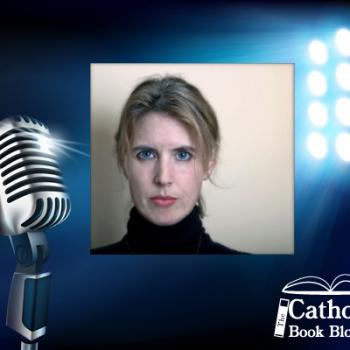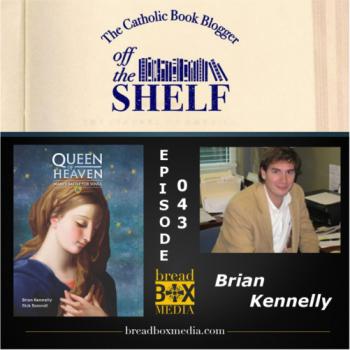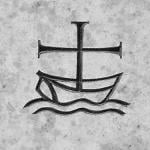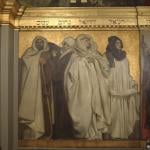 PETE: What inspired you to wrIte your novel about Blessed Pier Giorgio Frassati?
PETE: What inspired you to wrIte your novel about Blessed Pier Giorgio Frassati?
BRIAN KENNELLY: I hate to admit I actually didn’t know a thing about Pier Giorgio. My publisher, who did my first novel, Two Statues, called me and said they were thinking of doing a series of novels on modern saints. They asked if I wanted to write on Pier Giorgio. I wasn’t familiar with him so I ordered about 5 books and got to reading. I read about 10 pages of the first book on him and called them back and said, “Yes! I’ll do it! I love this guy!” As a 28 year old male, Pier Giorgio was very relatable and so I wanted to jump at the opportunity. The whole thing was a blessing.
PETE: How much research was involved in writing your book To The Heights?
BRIAN KENNELLY: I spent about six-nine months researching his life before writing a single word. I read about 5-6 books, one of which was written by his sister, another of which was a book of his letters, and I watched two documentaries, one on EWTN. I also just did a bunch of reading about him online. With each book or documentary, I would take quick notes and move them to the side. Then I created an outline of his life – dividing it up by childhood, mother, father, sister, holy episodes of his life, death, etc… and on the outline I would reference the book and page number I found that bit of info on. When I sat down to actually start writing I had about 40 pages of notes on his life referring back to all these books and documentaries – I’d read through them and pray a little bit, and then start a chapter. It was difficult at first to morph concrete facts into story format, but once I got clicking it really became second nature. I felt like Pier Giorgio was over my shoulder guiding me!
PETE: What was the most inspiring story you discovered in your research on Blessed Pier?
BRIAN KENNELLY: Great question. This is like picking the cutest puppy in a new litter of black labs. I’d like to pick two, if I could. One was a story when he was about 5 or 6 years old. He went to what would best be known as a daycare in today’s world, along with his grandfather. They were donating some leftover food to the children. As his grandfather spoke with one of the nuns, Pier Giorgio saw a little boy, maybe 4 years old, sitting alone in the corner of the cafeteria. He approached the boy and found out he was sitting alone because he had a skin disease and everyone kept him quarantined to make sure the other children didn’t catch the sickness. Pier Giorgio was not concerned about this, and instead sat down and shared a bowl of soup with the boy and befriended him. This is a small instance but it shows from an early age how compassionate he was.
Another story that touched me was when the custodian at Pier Giorgio’s school lost his son. A year went by, and on the anniversary of the son’s death Pier Giorgio went to Mass and offered up the Holy Eucharist in honor of this fallen boy. He came to the custodian that day and told him how sorry he was that he had lost his son, and that he had gone to Mass to honor his late child. The custodian, whom most people probably didn’t talk to or even know his name, broke down in tears. He couldn’t believe this 13 year old boy would do such a thing. Again, this is just a small thing, but this sums up Pier Giorgio’s life. Many small acts of kindness for many people. This is why he is so inspirational.
PETE: There seems to be an increase in Catholic fiction lately. As an author and your work with St. Benedict Press, what do you think is driving this?
BRIAN KENNELLY: I’m not sure, but I love it! Perhaps it’s just a cyclical thing and we are on a fiction wave. But I still think 90% of the books out there are non-fiction, so it’s hardly much at all. I think non-fiction will always, and should always, be more prominent, but I’d like to see it be more of a 70/30 ratio. We need both forms of literature just like we need a mother and a father to raise us – together in harmony they create a healthy reading life that nurtures our soul.
But it’s tough to sell fiction. If you do a book on Pope Francis you immediately have an audience, and a big one. If you write a novel and you’re an unknown author, it’s hard to get that book out there beyond your friends and family. You need people to take a chance on you. I commend those Catholic publishers who will take a chance on fiction because we need more fiction in this market. Stories have the power to do much more in our lives than a non-fiction book. Alan Napleton, the head of the Catholic Marketing Network, told me he finished my first novel at 3 in the morning – he said he couldn’t put it down. No one finishes a non-fiction book at 3 in the morning. Stories can grip our lives and give our own stories more meaning. In the prologue of this book on Pier Giorgio I compare reading non-fiction to looking through binoculars, and fiction to looking through a kaleidoscope. Binoculars may seem to serve more of a purpose, but looking through a kaleidoscope takes your mind and soul away to another place where colors dazzle like nothing found in this life.
The beauty of writing stories about the saints is that it combines these two mediums – it tells a story but a true one. And so, I say that reading historical fiction like this is like looking through a telescope, a combination of binoculars and a kaleidoscope, so that you’re looking at the dazzling colors of the cosmos – something that is real but something that is beyond us.
I hope more people will write fiction and I hope more people will publish it, but that is mostly beyond me.
PETE: This is your second novel, the first being Two Statues. Do you have any other book projects in the works?
BRIAN KENNELLY: I’m always working on something. If the book on Pier Giorgio is well received I may pick another modern saint and write another one of these. But I do want to see how it is received first. It was risky to write this, meaning, I didn’t know how people would accept the fact that I am “speaking and thinking for a saint” when I am clearly not a saint. It’s one thing to write a book on Thomas Jefferson and fill in the holes of his life with literary license; it’s another to do it for a saint. I had to be careful in how I depicted Pier Giorgio, especially on the parts where I filled in the holes of his life we don’t know about. I know there are some people out there who might frown upon a “novel” about the saints, because you are making things up at times, but of course you do so with the utmost respect. People don’t seem to have a problem when you make a move about a saint and fill in some holes with literary license, but with a book they sometimes do. Not sure why.
So, if everything goes well, which so far it has, I’d like to tackle a few more saints. Padre Pio, Max Kolbe, the Little Flower, and others all come to mind, but I don’t know yet.
I’ve got 2-3 other novels I have written, not on the saints, that I’d like to get published, but I am just taking those one day at a time. You have to be incredibly patient if you are a writer. If you paint a portrait someone can tell you what they think about it in a few seconds. If you write a poem someone can read it in a few seconds or maybe minutes. If you write a song and sing it someone can tell you what they think of it in a few minutes. If you write a novel it might months or even years before anyone can read it or something can come of it. All writers must have patience, but the good news is that practicing it with your writing makes you practice it in your life too.
PETE: Time for my signature ending question. This is a blog about books. What is currently on your bookshelf to read?
BRIAN KENNELLY: Another good question. I should plug my own publisher here and say I am about to start reading Bergoglio’s List. This is our new book from Saint Benedict Press. It is essentially a “Pope Francis version of Schindler’s List.” It is the true story of how a young Francis, then Father Bergoglio, saved many people’s lives during the Dirty War in Argentina. He hid them in attics and car trucks, and snuck people out of the country, a lot of really neat stuff like that. It’s amazing this story is not better known. I’m really excited to read it.
I also just finished reading a book that had more of a spiritual impact on me than any book I had hitherto read. It was The Sinner’s Guide, but Venerable Louis of Grenda. Please, if anyone out there is struggling with temptation and sin, buy this book tomorrow. It is lengthy and deep, but it was like holding up a mirror to my soul. This seems to be a book that is not talked about as much as Imitation of Christ or True Devotion to Mary or Story of a Soul, but it is just as powerful. Venerable Louis was the favorite author of St. Teresa of Avila.
_______________________________________________________________________________________________________
Also by Brian Kennelly:
Two Statues











